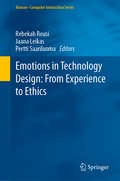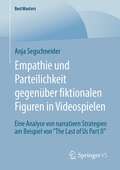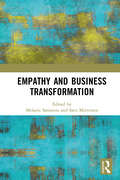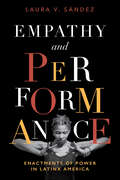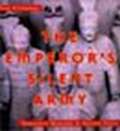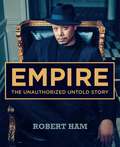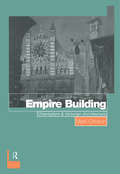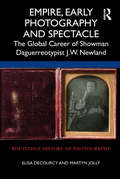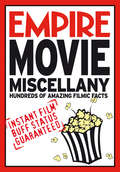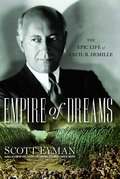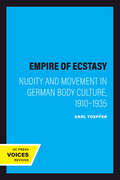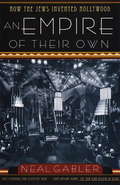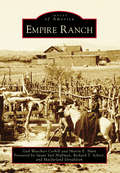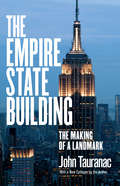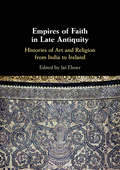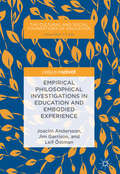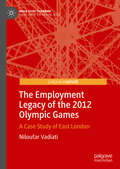- Table View
- List View
Emotions in Technology Design: From Experience to Ethics (Human–Computer Interaction Series)
by Rebekah Rousi Jaana Leikas Pertti SaariluomaUnderstanding emotions is becoming ever more valuable in design, both in terms of what people prefer as well as in relation to how they behave in relation to it. Approaches to conceptualising emotions in technology design, how emotions can be operationalised and how they can be measured are paramount to ascertaining the core principles of design. Emotions in Technology Design: From Experience to Ethics provides a multi-dimensional approach to studying, designing and comprehending emotions in design. It presents emotions as understood through basic human-technology research, applied design practice, culture and aesthetics, ethical approaches to emotional design, and ethics as a cultural framework for emotions in design experience. Core elements running through the book are: cognitive science – cognitive-affective theories of emotions (i.e., Appraisal); culture – the ways in which our minds are trained to recognise, respond to and influence design; and ethics – a deep cultural framework of interpretations of good versus evil. This ethical understanding brings culture and cognition together to form genuine emotional experience. This book is essential reading for designers, technology developers, HCI and cognitive science scholars, educators and students (at both undergraduate and graduate levels) in terms of emotional design methods and tools, systematic measurement of emotion in design experience, cultural theory underpinning how emotions operate in the production and interaction of design, and how ethics influence basic (primal) and higher level emotional reactions. The broader scope equips design practitioners, developers and scholars with that ‘something more’ in terms of understanding how emotional experience of technology can be positioned in relation to cultural discourse and ethics.
Empathetic Space on Screen
by Amedeo D'AdamoIn this book we learn that there is a clear but complex relationship between setting and character on screen. Certain settings stand out above others—think of the iconic gooey dripping tunnels that Ripley stumbles through in Aliens, Norman’s bird-decorated parlour in Psycho or the dark Gotham of certain Batman movies. But what makes these particular settings so powerful and iconic? Amedeo D’Adamo explains why we care about and cry for certain characters, and then focuses on how certain places then become windows onto their emotional lives. Using popular case studies such as Apocalypse Now, Amelie, Homeland and The Secret Garden, this original and insightful book is the first to really explain what makes some settings so effective, revealing an important but as yet uncovered machinery of empathy in visual narrative space. An invaluable resource for students, academics and indeed young filmmakers designing their very own narratives for space on screen.
Empathie und Parteilichkeit gegenüber fiktionalen Figuren in Videospielen: Eine Analyse von narrativen Strategien am Beispiel von “The Last of Us Part II” (BestMasters)
by Anja SegschneiderWie entstehen Empathie und Parteilichkeit in interaktiven Medien? Ausgehend von der These, dass interaktive Medien wie Videospiele eher dazu in der Lage sind, Empathie und Parteilichkeit zu erzeugen als lineare Medien, geht die Arbeit dieser Frage nach. Als Beispiel dient das populäre Survival-Horror-Spiel „The Last of Us Part II“ aus dem Jahr 2020. Das theoretische Fundament bilden bestehende Theorien aus Film- und Medienwissenschaft sowie der Psychologie, die auf das interaktive Medium übertragen und angepasst werden. Ein Fokus liegt auf narrativen und ludonarrativen Strategien. Dabei schlägt die Arbeit auch einen Bogen zu gesamtgesellschaftlichen Trends in den Medien und analysiert, inwiefern die Strategien für Parteilichkeit und Empathie in interaktiven Medien einen nachhaltigen Einfluss in der realen Welt entfalten können.
Empathy and Business Transformation
by Melanie Sarantou Satu MiettinenDue to its potential transformative nature, empathy has increasingly received attention in business, psychology, neuroscience, education, medicine, social sciences and design, to mention only a few. During the last two decades, discussions about the role of empathy in design and creative research and practice have developed, with empathy perceived as a key instrument in human-centred design and design thinking. This book revisits the powerful concept of empathy in the new post-pandemic era in which ubiquitous digitalisation presents challenges to retaining human-centredness when developing products and services. The book presents a practical four-step approach to the challenges presented concerning how organisations can turn from merely feeling empathy with or for people, to actions of empathy and compassion that can be implemented with and by communities. A wide range of organisations and organisational settings can benefit from the presented case studies and research methods. Through them, the book explores how to discover, share and act with empathy and compassion in the new digitally driven post-pandemic era to innovate across a wide range of organisations, including for-profit and not-for-profit businesses and those in the public and third sectors. This edited volume will appeal to global researchers in the fields of product and service design and digital, social innovation, as well those interested in organisational development. The practical, interdisciplinary nature of the book and innovative four-step approach will also appeal to upper-level students.
Empathy and Performance: Enactments of Power in Latinx America (Performing Latin American and Caribbean Identities)
by Laura V. SándezEmpathy and Performance advances a study of empathy and enactments of power by examining works from author-actors whose performances explore the boundaries between two kinship positions. Author Laura V. Sández studies the dramatized dilemma of cultural understanding in &“Our America,&” a notion that refers first to a collective political identity marking a common belonging in the Spanish-speaking America but also alludes to current struggles in the contemporary US. This book sees empathy as an affective response grounded in subjectivity and kinship. Sández argues that to conceptualize empathy one needs to understand how subjects organize, classify, and limit themselves, not only as agents, but also as interpreters. What sort of affiliations do these performances promote? How do they break, reinforce, or queer societal expectations about the Latinx body, the white body, or simply, the staged body? To survey different answers to these queries, Sández studies Indigurrito (Nao Bustamante); Dominicanish (Josefina Báez); ¡Bienvenidos Blancos! or Welcome White People! (Alex Torra); the apology delivered by the group Veterans Stand with Standing Rock during protests against the Dakota Access Pipeline; and Kukuli Velarde&’s body of work, from We, the Colonized Ones to A Mi Vida. In these artistic enactments, which range from 1992 to 2021, the historical construct of boundaries and bodies becomes evident. Following recent work on empathy by Lanzoni, Maibom, Calloway-Thomas, Bloom, Hogan, and Matravers, among others, Sández examines in-group/out-group divisions, the establishment of identity categories through performance, and the exploration of subaltern identities.
The Emperor and the World
by Alicia WalkerByzantine imperial imagery is commonly perceived as a static system. In contrast to this common portrayal, this book draws attention to its openness and responsiveness to other artistic traditions. Through a close examination of significant objects and monuments created over a 350-year period, from the ninth to the thirteenth century, Alicia Walker shows how the visual articulation of Byzantine imperial power not only maintained a visual vocabulary inherited from Greco-Roman antiquity and the Judeo-Christian tradition, but also innovated on these artistic precedents by incorporating styles and forms from contemporary foreign cultures, specifically the Sasanian, Chinese, and Islamic worlds. In addition to art and architecture, this book explores historical accounts and literary works as well as records of ceremonial practices, thereby demonstrating how texts, ritual, and images operated as integrated agents of imperial power. Walker offers new ways to think about cross-cultural interaction in the Middle Ages and explores the diverse ways in which imperial images employed foreign elements in order to express particularly Byzantine meanings.
The Emperor’s Silent Army: Terracotta Warriors of Ancient China
by Jane O'ConnorDescribes the archaeological discovery of thousands of life-sized terracotta warrior statues in northern China in 1974, and discusses the emperor who had them created and placed near his tomb.
Empire
by Robert HamAn unofficial guide to EMPIRE, the runaway hit of the 2014-15 television season.Empire is the breakout, network television hit of 2015--from its opening night, viewers were riveted by the story of record company magnate Lucious Lyon and his family, and the struggle for control over Empire Entertainment. As the second season approaches this September, Empire: The Unauthorized Untold Story tells you everything you need to know about this powerful drama. You'll get full backgrounds on all the major players, including the real-life entertainment icons on whom their stories are based. You'll learn about the music and fashions that helped drive the show's success. And you'll get a hint of what the second season might hold as show creators Lee Daniels and Danny Strong prepare to build on their phenomenal opening act.
Empire Builders: An Illustrated History of the Rise and Fall of Cleveland's Van Sweringen Brothers
by Lauren R. PaciniEmpire Builders tells the story of Oris P. and Mantis J. Sweringen, two brothers from Wooster, Ohio, in the late nineteenth and early twentieth centuries. Although they were born into abject poverty, Oris was an extraordinary visionary who, with the help of his devoted younger brother, amassed a vast fortune in real estate and railroad developments. Their major breakthrough came in 1913 with the establishment of Shaker Heights, an affluent garden suburb connected by a brand-new interurban railroad to the booming midwestern metropolis of Cleveland. The Van Sweringens' ascension after Shaker Heights was meteoric, and it culminated with the construction of the 52-story Terminal Tower in downtown Cleveland in 1927. However, the country's economy came crashing down after the 1929 stock market collapse, and their empire crumbled around them. Empire Builders is the first new biography of the Van Sweringen brothers in more than twenty years. In it, architectural photographer and local history author Lauren R. Pacini tells the remarkable story of the Van Sweringen brothers through words and images. This richly illustrated volume features more than 150 new photographs of the still-fabulous historic homes the brothers built throughout greater Cleveland.The foreword is written by John J. Grabowski.
Empire Building: Orientalism and Victorian Architecture
by Mark CrinsonThe colonial architecture of the nineteenth century has much to tell us of the history of colonialism and cultural exchange. Yet, these buildings can be read in many ways. Do they stand as witnesses to the rapacity and self-delusion of empire? Are they monuments to a world of lost glory and forgotten convictions? Do they reveal battles won by indigenous cultures and styles? Or do they simply represent an architectural style made absurdly incongruous in relocation? Empire Building is a study of how and why Western architecture was exported to the Middle East and how Islamic and Byzantine architectural ideas and styles impacted on the West. The book explores how far racial theory and political and religious agendas guided British architects (and how such ideas were resisted when applied), and how Eastern ideas came to influence the West, through writers such as Ruskin and buildings such as the Crystal Palace. Beautifully written and lavishly illustrated, Empire Building takes the reader on an extraordinary postcolonial journey, backwards and forwards, into the heart and to the edge of empire.
Empire, Early Photography and Spectacle: The Global Career of Showman Daguerreotypist J.W. Newland (Routledge History of Photography)
by Elisa deCourcy Martyn JollyJames William Newland’s (1810–1857) career as a showman daguerreotypist began in the United States but expanded into Central and South America, across the Pacific to New Zealand and colonial Australia and onto India. Newland used the latest developments in photography, theatre and spectacle to create powerful new visual experiences for audiences in each of these volatile colonial societies. This book assesses his surviving, vivid portraits against other visual ephemera and archival records of his time. Newland’s magic lantern and theatre shows are imaginatively reconstructed from textual sources and analysed, with his short, rich career casting a new light on the complex worlds of the mid-nineteenth century. It provides a revealing case study of someone brokering new experiences with optical technologies for varied audiences at the forefront of the age of modern vision. This book will be of interest to scholars in art and visual culture, photography, the history of photography and Victorian history.
Empire Films and the Crisis of Colonialism, 1946–1959
by Jon CowansThe first transnational history of cinema’s role in decolonization.Using popular cinema from the United States, Britain, and France, Empire Films and the Crisis of Colonialism, 1946–1959, examines postwar Western attitudes toward colonialism and race relations. Historians have written much about the high politics of decolonization but little about what ordinary citizens thought about losing their empires. Popular cinema provided the main source of images of the colonies, and, according to Jon Cowans in this far-reaching book, films depicting the excesses of empire helped Westerners come to terms with decolonization and even promoted the dismantling of colonialism around the globe.Examining more than one hundred British, French, and American films from the post–World War II era, Cowans concentrates on movies that depict interactions between white colonizers and nonwhite colonial subjects, including sexual and romantic relations. Although certain conservative films eagerly supported colonialism, Cowans argues that the more numerous "liberal colonialist" productions undermined support for key aspects of colonial rule, while a few more provocative films openly favored anticolonial movements and urged "internal decolonization" for people of color in Britain, France, and the United States.Combining new archival research on the films’ production with sharp analysis of their imagery and political messages, the book also assesses their reception through box-office figures and newspaper reviews. It examines both high-profile and lesser-known films on overseas colonialism, including The King and I, Bhowani Junction, and Island in the Sun, and tackles treatments of miscegenation and "internal colonialism" that appeared in Westerns and American films like Pinky and Giant. The first truly transnational history of cinema’s role in decolonization, this powerful book weaves a unified historical narrative out of the experiences of three colonial powers in diverse geographic settings.
Empire Movie Miscellany: Instant Film Buff Status Guaranteed
by Empire MagazineFrom the team who brought you The Empire Film Guide, here are all the obscure, indecent and downright bizarre movie facts and figures that were not considered sensible for a practical film guide. Discover which country translated GI Jane as Satan Female Soldier, which Hollywood heartthrob is the lead singer of 30 Odd Foot of Grunts, and which country takes a bag of toasted leaf cutter ants to the cinema instead of popcorn! The Schott's Miscellany of movies, packed full of movie facts, figures and lists, as well as explanations of filmmaking terminology and a "shot miscellany" - a list of all the various camera shots. You will soon know your Oscar Hosts from your Monty Python French insults, and never be short of small talk again!
The Empire of Business
by Andrew CarnegieThis book contains several articles and speeches by Andrew Carnegie, one of the most important industrialists of the end of the 19th and beginning of the 20th century in the United States; the man who would later inspire Napoleon Hill to write "Think and Grow Rich". His ideas on How to win fortune, the importance of wealth, and how young people can succeed, inspired generations. In his philanthropic work, he created and funded a network of public libraries in the United States, and funded places for culture as the Carnegie Hall in New York. A great man, with timeless ideas and wisdom that we can now enjoy.-Print ed.
Empire of Dreams: The Epic Life of Cecil B. DeMille
by Scott EymanBEST KNOWN AS THE DIRECTOR of such spectacular films as The Ten Commandments and King of Kings, Cecil B. DeMille lived a life as epic as any of his cinematic masterpieces. As a child DeMille learned the Bible from his father, a theology student and playwright who introduced Cecil and his older brother, William, to the theater. Tutored by impresario David Belasco, DeMille discovered how audiences responded to showmanship: sets, lights, costumes, etc. He took this knowledge with him to Los Angeles in 1913, where he became one of the movie pioneers, in partnership with Jesse Lasky and Lasky’s brother-in-law Samuel Goldfish (later Goldwyn). Working out of a barn on streets fragrant with orange blossom and pepper trees, the Lasky company turned out a string of successful silents, most of them directed by DeMille, who became one of the biggest names of the silent era. With films such as The Squaw Man, Brewster’s Millions, Joan the Woman, and Don’t Change Your Husband, he was the creative backbone of what would become Paramount Studios. In 1923 he filmed his first version of The Ten Commandments and later a second biblical epic, King of Kings, both enormous box-office successes. Although his reputation rests largely on the biblical epics he made, DeMille’s personal life was no morality tale. He remained married to his wife, Constance, for more than fifty years, but for most of the marriage he had three mistresses simultaneously, all of whom worked for him. He showed great loyalty to a small group of actors who knew his style, but he also discovered some major stars, among them Gloria Swanson, Claudette Colbert, and later, Charlton Heston. DeMille was one of the few silent-era directors who made a completely successful transition to sound. In 1952 he won the Academy Award for Best Picture with The Greatest Show on Earth. When he remade The Ten Commandments in 1956, it was an even bigger hit than the silent version. He could act, too: in Billy Wilder’s classic film Sunset Boulevard, DeMille memorably played himself. In the 1930s and 1940s DeMille became a household name thanks to the Lux Radio Theater, which he hosted. But after falling out with a union, he gave up the program, and his politics shifted to the right as he championed loyalty oaths and Sen. Joseph McCarthy’s anticommunist witch hunts. As Scott Eyman brilliantly demonstrates in this superbly researched biography, which draws on a massive cache of DeMille family papers not available to previous biographers, DeMille was much more than his clichéd image. A gifted director who worked in many genres; a devoted family man and loyal friend with a highly unconventional personal life; a pioneering filmmaker: DeMille comes alive in these pages, a legend whose spectacular career defined an era.
Empire of Ecstasy: Nudity and Movement in German Body Culture, 1910–1935 (Weimar and Now: German Cultural Criticism #13)
by Karl ToepferEmpire of Ecstasy offers a novel interpretation of the explosion of German body culture between the two wars—nudism and nude dancing, gymnastics and dance training, dance photography and criticism, and diverse genres of performance from solo dancing to mass movement choirs. Karl Toepfer presents this dynamic subject as a vital and historically unique construction of "modern identity." The modern body, radiating freedom and power, appeared to Weimar artists and intelligentsia to be the source of a transgressive energy, as well as the sign and manifestation of powerful, mysterious "inner" conditions. Toepfer shows how this view of the modern body sought to extend the aesthetic experience beyond the boundaries imposed by rationalized life and to transcend these limits in search of ecstasy. With the help of much unpublished or long-forgotten archival material (including many little-known photographs), he investigates the process of constructing an "empire" of appropriative impulses toward ecstasy. Toepfer presents the work of such well-known figures as Rudolf Laban, Mary Wigman, and Oskar Schlemmer, along with less-known but equally fascinating body culture practitioners. His book is certain to become required reading for historians of dance, body culture, and modernism.
An Empire of Their Own: How the Jews Invented Hollywood
by Neal GablerA provocative, original, and richly entertaining group biography of the Jewish immigrants who were the moving forces behind the creation of America's motion picture industry. The names Harry Cohn, William Fox, Carl Laemmle, Louis B. Mayer, Jack and Harry Warner, and Adolph Zucker are giants in the history of contemporary Hollywood, outsiders who dared to invent their own vision of the American Dream. Even to this day, the American values defined largely by the movies of these émigrés endure in American cinema and culture. Who these men were, how they came to dominate Hollywood, and what they gained and lost in the process is the exhilarating story of An Empire of Their Own.
Empire Ranch
by Gail Waechter Corkill Sharon E. HuntThe Empire Ranch sits in the heart of the rolling grasslands and oak-studded foothills of Las Cienegas National Conservation Area in southeastern Arizona. Its remarkable history and the ranching way of life are told through the stories of the men, women, and children of the Empire, most notably the Vail, Boice, and Donaldson families. Walter L. Vail and Herbert R. Hislop purchased the Empire Ranch homestead for $2,000 in 1876. The Vail family operated the ranch until 1928, turning it into a cattle ranching empire. From 1928 to 1975, the well-respected Boice family ran a vibrant Hereford operation on the Empire. The Donaldson family used innovative range management methods to continue the ranching legacy from 1975 to 2009. Today, the ranch, under the management of the Bureau of Land Management, remains one of the oldest continuously working cattle ranches in the region.
The Empire State Building: The Making of a Landmark
by John TauranacThe Empire State Building is the landmark book on one of the world's most notable landmarks. Since its publication in 1995, John Tauranac's book, focused on the inception and construction of the building, has stood as the most comprehensive account of the structure. Moreover, it is far more than a work in architectural history; Tauranac tells a larger story of the politics of urban development in and through the interwar years. In a new epilogue to the Cornell edition, Tauranac highlights the continuing resonance and influence of the Empire State Building in the rapidly changing post-9/11 cityscape.
Empires of Faith in Late Antiquity: Histories of Art and Religion from India to Ireland
by Jaś ElsnerThis book reveals the rewards of exploring the relationship between art and religion in the first millennium, and the particular problems of comparing the visual cultures of different emergent and established religions of the period in Eurasia - Buddhism, Hinduism, Zoroastrianism, Islam, Judaism, Christianity and the pagan religions of the Roman world. Most of these became established and remained in play as what are called 'the world religions'. The chapters in this volume show how the long traditions of studying these topics are caught up in complex local, ancestral, colonial and post-colonial discourses and biases, which have made comparison difficult. The study of Late Antiquity turns out also to be an examination of the intellectual histories of modernity.
Empires of Vision: A Reader
by Martin Jay Sumathi RamaswamyEmpires of Vision brings together pieces by some of the most influential scholars working at the intersection of visual culture studies and the history of European imperialism. The essays and excerpts focus on the paintings, maps, geographical surveys, postcards, photographs, and other media that comprise the visual milieu of colonization, struggles for decolonization, and the lingering effects of empire. Taken together, they demonstrate that an appreciation of the role of visual experience is necessary for understanding the functioning of hegemonic imperial power and the ways that the colonized subjects spoke, and looked, back at their imperial rulers. Empires of Vision also makes a vital point about the complexity of image culture in the modern world: We must comprehend how regimes of visuality emerged globally, not only in the metropole but also in relation to the putative margins of a world that increasingly came to question the very distinction between center and periphery.Contributors. Jordanna Bailkin, Roger Benjamin, Daniela Bleichmar, Zeynep Çelik, David Ciarlo, Natasha Eaton, Simon Gikandi, Serge Gruzinski, James L. Hevia, Martin Jay, Brian Larkin, Olu Oguibe, Ricardo Padrón, Christopher Pinney, Sumathi Ramaswamy, Benjamin Schmidt, Terry Smith, Robert Stam, Eric A. Stein, Nicholas Thomas, Krista A. Thompson
Empirical Philosophical Investigations in Education and Embodied Experience (The\cultural And Social Foundations Of Education Ser.)
by Joacim Andersson Jim Garrison Leif ÖstmanDrawing on John Dewey and the later Ludwig Wittgenstein, this book employs philosophy as a conceptual resource to develop new methodological and analytical tools for conducting in situ empirical investigations. Chapter one explores the philosophies of Wittgenstein and Dewey. Chapter two exposits Deweyan ideas of embodiment, the primacy of the aesthetic encounter, and aesthetically expressive meaning underdeveloped in Wittgenstein. Chapter three introduces the method of practical epistemological analysis (PEA) and a model of situated epistemic relations (SER) to investigate the learning of body techniques in dinghy sailing. The concluding chapter introduces a model of situated artistic relations (SAR) to investigate the learning of artistic techniques of self-expression in the Swedish sloyd classroom.
The Empirical Validation of House Energy Rating (HER) Software for Lightweight Housing in Cool Temperate Climates
by Mark Andrew DewsburyThis book reports on the first empirical validation of "AccuRate," Australia's national benchmark software tool for house energy ratings. The validation was conducted by the University of Tasmania in collaboration with Forest and Wood Products Australia, the Australian Government, the CSIRO and industry partners. The study presented here describes the results of graphical and statistical analysis of variations observed between the measured and simulated data from three different test buildings in Launceston, Tasmania. It shows that, while the AccuRate software is well suited to modeling energy flows, there are discrepancies between the simulated and measured temperatures of the test buildings. Moreover, it highlights possible connections between the discrepancies in all zones and the outside air temperature, wind speed, global and diffuse solar radiation, and possibly the ground model. Beyond its contribution to further investigations into the ongoing improvement and calibration of the Australian NatHERS-supported AccuRate software, this book also meticulously describes the methodology used in conducting the research, which is expected to pave the way for further studies of this type.
Employees Must Wash Hands: A Bathroom Reader in Pictures
by Carter HasegawaFinally, photographic proof of what’s behind the public bathroom door.Must Wash Hands, a collection of 120 artistic photographs, offers readers a peek into the private space of the public bathroom-that unspoken and indecent yet communal and necessary space that we enter and exit every day without a second glance.With camera in hand, Carter Hasegawa travels the public bathrooms of Boston, New York, Seattle, Las Vegas, Honolulu, Indianapolis, and other American cities, snapping photos down urinals and documenting graffitied walls and wet, toilet paper-plastered floors. Photos are arranged "chronologically” as a virtual public restroom walkthrough for the reader, and they highlight unsavory and savory bathroom elements you otherwise may not have noticed-ice cubes down a urinal, unconventional "Employees Must Wash Hands” signs, interesting tile details, or a jar of baby food on the floor. These wry but intimate photos are interspersed with popular bathroom trivia, illegally overheard bathroom conversations, half-serious comments on "proper” bathroom etiquette, and seriously real anecdotes.For fans of offbeat photography and humor books such as Awkward Family Photos, People of Walmart, and Regretsy, Must Wash Hands transforms the crude and disgusting into something more compelling and beautiful, prompting the viewer to pause, admire, laugh, and connect.
The Employment Legacy of the 2012 Olympic Games: A Case Study of East London (Mega Event Planning)
by Niloufar VadiatiThis book offers a detailed account of the employment promises made to local East Londoners when the Summer Olympic Games 2012 were awarded to London, as well as an examination of how those promises had morphed into the Olympic Labor market jamboree from which local communities were excluded.Regarding the global job market of London, this study provides a nuanced empirical view on how the world’s biggest mega event was experienced and endured in terms employment by its immediate hosts, in one of the UK’s poorest, most ethnically complex, and transient areas. The data has been collected through ethnographic observation and interviews with local residents, and expert interviews with the Olympic delivery professionals. Using Bourdieusian theory of contested capital, the findings provide an important bearing on the reproduction of inequality in the local labor markets of Olympic host cities.
